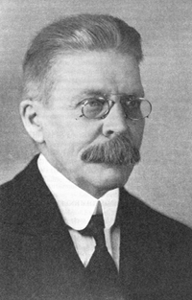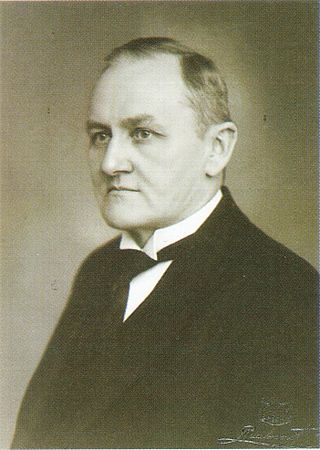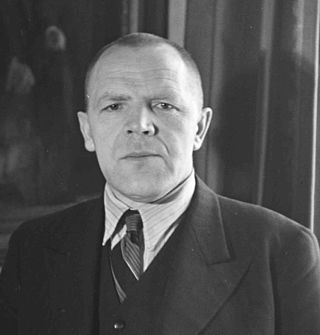
Kyösti Kallio was a Finnish politician who served as the fourth president of Finland from 1937 to 1940. His presidency included leading the country through the Winter War; while he relinquished the post of commander-in-chief to Carl Gustaf Emil Mannerheim, he played a role as a spiritual leader. After the war, he became both the first President of Finland to resign and the only one to die in office, dying of a heart attack while returning home after submitting his resignation.

Lauri Kristian Relander was the second president of Finland (1925–1931). A prominent member of the Agrarian League, he served as a member of Parliament, and as Speaker, before his election as President.

Risto Heikki Ryti was a Finnish politician who served as the fifth president of Finland from 1940 to 1944. Ryti started his career as a politician in the field of economics and as a political background figure during the interwar period. He made a wide range of international contacts in the world of banking and within the framework of the League of Nations. Ryti served as prime minister during the Winter War and the Interim Peace, and as president during the Continuation War.

Aimo Kaarlo Cajander was the Prime Minister of Finland up to the Winter War.

The Centre Party, officially the Centre Party of Finland, is an agrarian-centrist political party in Finland. Ideologically, the Centre Party is positioned in the centre on the political spectrum. It has been described as liberal, social-liberal, liberal-conservative, and conservative-liberal. The party’s leader is Annika Saarikko, who was elected in September 2020 to follow Katri Kulmuni, the former finance minister of Finland. As of December 2019, the party has been a coalition partner in the Marin Cabinet, led by Prime Minister Sanna Marin of the Social Democratic Party (SDP).

Oulu is one of the 13 electoral districts of the Parliament of Finland, the national legislature of Finland. The district was established as Oulu Province South in 1907 when the Diet of Finland was replaced by the Parliament of Finland. It was renamed Oulu Province in 1939 and Oulu in 1997. It is conterminous with the regions of Kainuu and North Ostrobothnia. The district currently elects 18 of the 200 members of the Parliament of Finland using the open party-list proportional representation electoral system. At the 2023 parliamentary election it had 393,643 registered electors.

Johan (Juho) Emil Sunila was a Finnish politician from the Agrarian League, the managing director of the agrarian finance board, and Prime Minister of Finland in two cabinets. He was born in Liminka.
Parliamentary elections were held in Finland between 1 and 3 July 1922. The Social Democratic Party remained the largest in Parliament with 53 of the 200 seats. The caretaker government of Professor Aimo Cajander (Progressive), that President Kaarlo Juho Ståhlberg had appointed in June 1922, following the resignation of Prime Minister Juho Vennola (Progressive), remained in office until Kyösti Kallio formed an Agrarian-Progressive minority government in November 1922. Voter turnout was 58.5%.
Parliamentary elections were held in Finland on 1 and 2 April 1924. Although the Social Democratic Party remained the largest in Parliament with 60 of the 200 seats, Lauri Ingman of the National Coalition Party formed a centre-right majority government in May 1924. It remained intact until the Agrarians left in November 1924. Voter turnout was 57.4%.
Parliamentary elections were held in Finland on 1 and 2 July 1927. Although the Social Democratic Party remained the largest in Parliament with 60 of the 200 seats, Juho Sunila of the Agrarian League formed an Agrarian minority government in December 1927. It remained intact until December 1928. Voter turnout was 55.8%.
Parliamentary elections were held in Finland on 1 and 2 July 1936. Following the election Prime Minister Toivo Mikael Kivimäki of the National Progressive Party was defeated in a confidence vote in September 1936 and resigned in October. Kyösti Kallio of the Agrarian League formed a centrist minority government after Pehr Evind Svinhufvud refused to allow the Social Democrats to join the government. After Svinhufvud's defeat in the February 1937 presidential election, Kallio took office as the new President in March 1937, and he allowed the Social Democrats, Agrarians and Progressives to form the first centre-left or "red soil" Finnish government. Aimo Cajander (Progressive) became Prime Minister, although the real strong men of the government were Finance Minister Väinö Tanner and Defence Minister Juho Niukkanen (Agrarian).

Johan Wilhelm (Jukka) Rangell was the Prime Minister of Finland from 1941 to 1943.
Kyösti Kallio's first cabinet was the eighth Government of the Republic of Finland. The cabinet's time period was November 14, 1922 – January 18, 1924. It was minority government.

Viljami Kalliokoski was a Finnish farmer and politician. He was a member of the Agrarian League.
Agrarian parties of Finland were and their successors are a typical part of the development in the Nordic countries, which has been based on milk production in distant and relatively sparsely populated areas. The state support for small peasants was one of the essential economic reforms in the newly independent Finland just after the declaration of independence in 1917 and fierce civil war of 1918. Already in 1917 the land reform, which had been discussed for more than ten years seriously in the parliament was executed. The tendency toward increasing small farming continued in various other reforms like Lex Kallio, which made it possible for the small peasants to achieve more lands. This made parliamentary life fragile in Finland as the reforms created mistrust between the Agrarian League lea mainly by Kyösti Kallio and the National Coalition party, which favoured bigger land-owners. Between the world wars strong agrarian movements were not only in the Nordic countries, but also in Bulgaria.
Two-stage presidential elections were held in Finland in 1937. The first stage was on 15 and 16 January 1937 as the public selected 300 presidential electors to an electoral college.

Kerttu Saalasti was a Finnish politician who was the Finland Minister of Education from 1954 to 1956 and from May 1957 to November 1957. She was the first female Minister of Education in Finland, and introduced the legislation that established the University of Oulu. A member of the Agrarian League, Saalasti also represented Oulu in the Parliament of Finland from 1948 to 1962 and from 1966 to 1970.

Bruno Jalander was a Finnish military officer who served as minister of war in the post-World War I period between 1920 and 1923.
Katri Kaarlonen was a Finnish politician, who served as a Member of Parliament for the Turku Province (south) constituency, representing the Centre Party.











